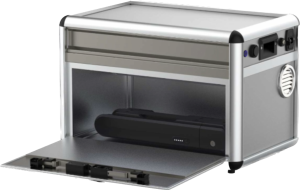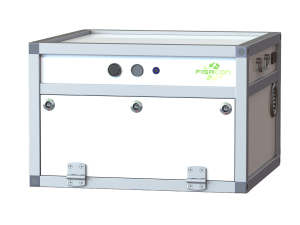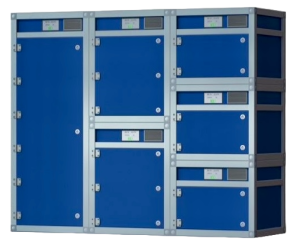Discover Lithium-Ion Battery Problems and Real Solutions
Discover Lithium-Ion Battery Problems and Real Solutions
Since 2021, more than 90 yachts have been damaged or destroyed by fire…NINETY! More than 19 of these were superyachts, with e-bikes and water toys with lithium-ion batteries on board. Insurance agencies and even yacht classification registries have taken note and have begun to take action. The move from “recommendation” to “regulation” may be on the horizon for yachts.
As we increase the use of renewable energy, innovation steers us towards sustainable solutions. Lithium-ion batteries emerged as the ‘silent heroes’, propelling us towards a future where eco-friendly practices are the norm. These batteries have certainly played a pivotal role in reducing energy consumption worldwide, and are growing in popularity in the maritime industry, especially in water toys and yachts. Electric is going nowhere soon, but we should not turn a blind eye to the lurking dangers.
Manufacturer information says that every 10,000th lithium-ion battery cell is defective. This has the potential to cause a disaster. When you are thousands of nautical miles from land, would you really take a chance?
The Pros And Cons Of Lithium-ion Batteries
Lithium-ion batteries have revolutionized energy storage with their high energy density, longer lifespan, and lightweight design. They are key players in fostering sustainability, reducing our carbon footprint, and enhancing the efficiency of many of our every day products, such as cordless tools, smart phones, laptops and electric land and watercraft, including water toys for yachts.
However, like any technology, lithium-ion batteries come with their own set of challenges. Improper handling, charging, and monitoring can lead to hazards that pose risks to both the environment and individuals on board. As the maritime industry increasingly adopts these batteries, it becomes imperative to strike a balance between harnessing their potential and ensuring safety at sea.
What Is Thermal Runaway?
Thermal runaway refers to a self-perpetuating and uncontrollable increase in temperature within a system, and in the context of lithium-ion batteries, it represents a critical and potentially hazardous condition. The process typically initiates with the release of heat during normal battery operation or under certain stressing conditions. This increase in temperature can trigger a chain reaction, further escalating the temperature, and leading to fire, explosions and the release of extremely toxic gases and smoke. Once thermal runaway starts, IT CANNOT BE STOPPED, and the resulting fire cannot be extinguished with traditional extinguishers on board. The battery can burn for days. Only permanent cooling, using a special agent, can reduce the action in the cells.
In lithium-ion batteries, thermal runaway is often triggered by factors such as un-monitored overcharging, external heat, manufacturing defects, or damage to the battery (such as dropping it).
As the temperature rises, it can cause a breakdown of the internal components, leading to increased heat generation and, in some cases, the release of flammable electrolytes.
This escalating cycle of rising temperatures can result in the battery reaching a point where it becomes difficult to control. At this stage, the battery can release hazardous gases, experience structural failure, and even ignite. The consequences of thermal runaway can include fires, explosions, and the production of extremely toxic fumes.
Mitigating the risk of thermal runaway in lithium-ion batteries involves incorporating safety mechanisms in battery design, monitoring systems to detect early signs of overheating, and most importantly, implementing proper charging practices to prevent stress on the battery cells. Understanding and managing thermal runaway is crucial to ensure the safe use of lithium-ion batteries in various applications, from everyday consumer electronics to the water toys on board luxury yachts.
Toxicity & Health Hazards
Lithium-ion battery fires pose not only the immediate danger of flames but also an often overlooked double-threat…toxic fumes. The combustion of these batteries generates not only smoke but also a hazardous blend of gases. In the aftermath of a fire, these batteries emit dangerous gases, including carbon monoxide, hydrogen fluoride, and hydrogen chloride. These fumes present a health risk, particularly when inhaled in substantial quantities, and when exposed to in enclosed spaces, such as garages, where the accumulation of noxious gases is swift. Of notable concern is hydrofluoric acid (HF), an aggressive acid produced during a thermal runaway. Disturbingly, HF is especially perilous as it can penetrate the body through the skin without causing immediate pain, leading to severe internal injuries that may prove fatal. This underscores the importance of addressing not only the visible dangers of lithium-ion battery fires but also the less apparent, yet equally harmful consequences associated with toxic gas emissions.
Navigating The Hazards
The hazardous nature of lithium-ion batteries, especially in marine environments, has prompted regulatory bodies to address safety concerns. The Cayman Island Shipping Registry emphasizes the need for holistic Risk Assessments (RAs) to tailor mitigation measures for every vessel. The evolving guidance from the UK MCA, as outlined in MGN 681, and subsequently adopted by the RED Ensign Group, underscores the importance of ongoing industry consultation to refine safety protocols.
The MCA ( Maritime Coastguard Agency) released the following publication, MGN 681 on June 2, 2023, which provides comprehensive guidelines on fire safety and storage of small electric-powered craft on yachts. These guidelines serve as a crucial reference for yacht owners and crew members navigating the complexities of lithium-ion battery usage. Request the full MGN681 document HERE.
“Small electrically powered craft and other vehicles (such as personal watercraft) are becoming more commonly used in place of similar petrol-powered craft or vehicles stowed on yachts. Whilst electric craft do not necessarily represent a greater fire risk than petrol craft, there are considerable differences in best practice for fire prevention, storage, fire detection and fire suppression of such craft, which should be considered when they are stored onboard. This guidance is provided for use where lithium-ion (Li-ion) batteries are used as the source of electrical power.” (Excerpt from MGN 681 (M) Fire safety and storage of small electric powered craft on yachts).
Request the full MGN681 document
These guidelines serve as a crucial reference for yacht owners and crew members navigating the complexities of lithium-ion battery usage.
Preventative Vs Reactive
Embracing preventative measures over reactive responses to lithium-ion battery hazards represents not only a strategic choice but a paramount commitment to safeguarding lives, reducing costs, and mitigating catastrophic consequences. This marks a paradigm shift in safety priorities. Proactive strategies, such as robust battery design, stringent manufacturing standards, safety protocols and advanced monitoring systems can possibly intercept potential risks at their inception, but cannot prevent the perilous escalation of thermal runaway if a cell is defective. By prioritizing preventative strategies, lives are safeguarded from the immediate and latent dangers of toxic fumes and the insidious effects of substances like hydrofluoric acid.
Beyond the immeasurable value of human safety, adopting preventative measures translates into substantial economic benefits, cutting the exorbitant costs associated with firefighting efforts, property damage, and medical treatments. The financial burden of damage control pales in comparison to the investment in preemptive safety measures.
The dividends of prevention extend further into environmental conservation, averting the release of hazardous materials, sparing ecosystems, and reducing the ecological fallout of battery-related incidents. In essence, a preemptive stance on lithium-ion battery safety is an investment in a safer, more resilient future and environmental integrity, where lives are preserved, costs curtailed, and the toll of catastrophic events substantially diminished. It is a true testament to the transformative power of foresight over hindsight.
The Importance Of Awareness, Competence and Training
Ensuring yacht crew awareness, training, and competency in the safe handling and charging of lithium-ion batteries stands as a paramount necessity, as articulated by the UK’s MCA maritime agency guidelines. Crew members must undergo comprehensive training encompassing the safe operation, storage, and charging of electric watercraft and associated vehicles. This training extends to the identification of potential damage and the proper procedures for disposal or quarantining of any compromised equipment or batteries. The integration of Safe Operating Procedures into the vessel’s Safety Management System is pivotal, with crew members assigned specific duties involving battery equipment receiving adequate familiarization and training to execute these responsibilities safely.
Furthermore, the guidelines emphasize the imperative inclusion of responses to battery fires within the vessel’s safety management systems. Regular drills for handling such fires, conducted at agreed-upon intervals, ensure a well-prepared crew. Crew members are required to be fully trained and competent in the use of specialized equipment designed for lithium-ion batteries, such as Li-ion specific fire extinguishers, fire blankets, and infrared cameras. The significance of recognizing early signs of battery problems is underscored, including understanding the challenges posed by the potential sudden onset of thermal runaway, the difficulty in extinguishing due to the self-sufficient nature of Li-ion batteries, the release of hazardous gases during battery fires, and the potential for re-ignition long after suppression.
A comprehensive post-incident action plan, covering the quarantine or disposal of batteries, coupled with a cleanup strategy compliant with local regulations, forms an integral part of crew training and the vessel’s safety management system. Designating a named person on-board as responsible for the safe operation, maintenance, and emergency response involving Li-ion batteries is a prudent recommendation in acknowledgment of the unique challenges posed by these batteries.
Discover our products
Li-Ion Battery Storage
We offer a secure off-site storage for Li-ion batteries and other DGR items. Batteries are stored in dry and secure environment. We the pick-up and delivery the batteries back to you at requested date/location. The Service includes regular charging and check-up. You can opt for weekly or monthly storage periods.
Competent Risk Assessments
Further communication with a Senior Surveyor of the Technical Department of The Cayman Registry, A Division of Cayman Maritime, revealed an important point that surveyors would like to stress. The surveyor highlights the importance of comprehensive risk assessment in addressing issues related to Lithium-ion batteries on yachts, as conveyed in the MCA’s recommendations. While this initial guidance has been adopted by the RED Ensign Group, including British Shipping Registers, he emphasizes that it does not cover every potential scenario, necessitating a case-by-case consideration. Holistic Risk Assessments (RAs) are deemed crucial to devising realistic mitigation measures on board.
He further points out that a recurring issue has been the inadequacy of many RAs in assessing risks and proposing mitigations accurately. He underscores that mitigation should never precede the risk assessment and cautions against implementing mitigations without a thorough, holistic assessment. He provides an example of proposals for lithium fire extinguishers that did not adequately consider factors such as the potential energy within batteries, firefighting measures, and the duration of protection needed in emergencies. He cautions that incomplete assessments could lead to escalating scenarios, emphasizing the need to delve deeper into the risks and mitigation strategies.
Safe Charging Protocols
The safe handling and charging of lithium-ion batteries on yachts is a critical aspect outlined by the MCA. The guidelines stress the importance of proper storage and charging practices, starting with compliance with REG Yacht Code Part A for spaces accommodating electric-powered personal watercraft. Dedicated cabinets, constructed according to international standards are advised for spare or removed batteries above 100Wh. All batteries must adhere to manufacturer parameters, including operational instructions, maintenance requirements, and permissible temperature ranges.
Moreover, the guidelines underscore the need for crew training in identifying early signs of battery problems, emphasizing the potential hazards of damaged batteries, including toxic gas emissions. Specific spatial considerations for battery charging activities are detailed, such as restrictions on locations within the vessel and requirements for emergency controls on shell doors. Temperature control and monitoring in charging and storage spaces for Li-ion batteries are highlighted, with a call for integration into ship alarms. Enhanced safety measures, certified safe electrical equipment, and ducted mechanical ventilation, are emphasized. The guidelines also address specific considerations for spaces with fuel, external storage of battery-driven craft, and charging station requirements. Competence of the crew , automatic stop mechanisms, and dedicated electrical circuits with safety devices further underscore the commitment to minimizing risks associated with lithium-ion batteries on yachts.
We must stress that the safe charging of lithium-ion batteries is paramount. The most likely moment for a thermal runaway to occur, is during the charging process. Adhering to correct protocols not only enhances safety but also prolongs the life of batteries, contributing to sustainable practice.
As we embrace the positive impact of lithium-ion batteries on energy efficiency, it is our collective responsibility to sail safely through the challenges they present. By understanding the pros and cons, adhering to safe charging protocols, and staying updated on industry guidelines, we can navigate the challenges with confidence, knowing that our journey towards sustainability is both innovative and secure. Ocean Premium has taken a proactive approach by offering cutting-edge solutions that aims to protect life, property and the environment.
In the near future, through its upcoming webinars and masterclass, Ocean Premium will delve more deeply into Risk Assessments and correct charging procedures, as well as the RAMBSS System and RACLAN Boxes, two viable solutions being made available to its customers along with partner, Fisacon. More information on the Masterclass will soon be made available.
Real Solutions
For detailed information on the RAMBSS System and the RACLAN Boxes, as seen in the above video, for the safe storage and charging of lithium-ion batteries in water toys, take a closer look at HERE.
Additional Resource:
For yacht crew seeking handy, go-to tips, the September issue of DOCKWALK Magazine provides simple advice for handling and storing lithium-ion batteries. Read tips HERE.
Discover our solutions
Li-Ion Battery Storage
We offer a secure off-site storage for Li-ion batteries and other DGR items. Batteries are stored in dry and secure environment. We the pick-up and delivery the batteries back to you at requested date/location. The Service includes regular charging and check-up. You can opt for weekly or monthly storage periods.



